They Shoot Film, Don't They?
Digital photography has been around long enough that you might think everyone has converted, but that's not quite the case. When video cameras appeared on the scene 8mm movie gear immediately became worthless. That hasn't been quite the case with film cameras, although I sold some old film gear a year ago and received less than a third of what I would have received if I'd sold it the same year I stopped using it. Film has a look that some people prefer, while others just don't trust digital storage. Eastman Kodak has a new Ektar film that I'm sure I would have loved. But since the only film camera I still own is an antique point-and-shoot, it's not too likely that I'll be loading it up with Kodak's latest professional film.
You may have wondered what the difference is between amateur film and professional film. Professional film is more closely monitored during the manufacturing process and the temperature is controlled during shipping and storage. The film typically comes with a sheet that indicates any color shift that's apparent in the particular batch of film. Because professionals tend to keep their lenses clean, professional film has a lower contrast ratio. Professional films also generally emphasize color accuracy over color saturation.
Professional photographers have been slow to accept digital photography despite what I consider to be its clear advantages over film. Some may question whether "art" can be created with a digital camera, but I suspect that many photographers are reluctant to replace equipment they're familiar with and methods they have used for decades. Change isn't easy.
Digital Advantages
If digital photography had no other advantage, this one should be sufficient to convince nearly everyone to switch away from film: Immediate feedback.
During the decade I worked as a professional photographer, I had lab workers tell me frequently that my color negatives were among the best exposed they encountered. That doesn't mean every exposure was perfect. Far from it. I had my share of disasters when a light didn't fire or a setting on a camera or light was wrong. Digital cameras show you instantly what the exposure looks like and most semi-pro and above cameras will even display a histogram.
- Cost. Some people will tell you that each exposure is essentially free, and that's accurate, if not entirely true. I remember photographing weddings and thinking, "Click. That's $1." I would sometimes skip taking a picture that looked promising because of the cost. A couple of years ago, I photographed a wedding for a friend and took nearly 500 pictures. There's no way I ever would have done that with a film camera. But each image was "free" -- no film and no processing. That's not the entire story, though, because the cost of the camera needs to be considered, too. A good film camera will last for a decade or more. New models of digital cameras make your current camera obsolete and you will end up replacing it it 3 to 5 years. Some of what you save in film and processing costs is simply transferred to equipment costs. But overall digital still wins.
- Post production. One of the reasons I (almost) always use the camera's raw format is that if, despite all precautions, something has gone wrong with the exposure, I can probably save it because the raw format contains every bit of information the camera's sensor saw. Whether I let the camera set the temperature of the light or do it manually, it can always be improved in post production. Likewise gamma, saturation, sharpness, and more. I've heard some misguided folks say that they won't shoot anything but jpg format because if you don't get the image exactly right at the instant of exposure, you don't deserve to have it.
- Speed. There's a big one. In the old days, I would return from a business or vacation trip, package up my film and send it to the lab, wait a week, review the resulting proofs, order prints, and mail the prints to friends. Today, I return from a trip, download the images to the computer, review and modify them, upload them to SmugMug or my own website, and let friends know that they can see the pictures. Instead of weeks, this process takes hours.
- Control. Even if you have your own darkroom (and I did have one), you don't have as much control as you do with programs such as Photoshop and Lightroom. Add some plug-ins and you'll expand your control.
Can Digital Photography be "Art"?
One of digital photography's most significant advantages is the ability to modify the resulting images in a program such as Adobe Photoshop. The available controls are nearly limitless in their ability to boost or retard all colors, some colors, or an individual color; to increase or decrease contrast; to modify the color balance; to sharpen or soften detail; and more. Lots more. You can make multiple copies of an image and try various effects to find the one that matches what you saw when you made the exposure or that looks like nothing that can be seen on this planet. The choice is yours. I've been experimenting with OnOne Software's Photo Tools 2, plug-ins for Photoshop and other applications that use the Photoshop standard. Having thought that I knew a little bit about creative effects, I have discovered the depths of my ignorance.
It's probably worthwhile to say that you don't need an application such as Photo Tools 2 because anything the plug-ins can do, you can do for yourself in Photoshop. But you'd have to know how. Any given Photo Tools effect may contain dozens of image modifications. Even if you knew how to accomplish each of the effects, doing so manually would take many minutes for each photograph, not the seconds required by Photo Tools.
That explains the company's slogan, Software that gets you back to shooting. Whether you're an amateur or a professional, you probably don't enjoy spending time applying layers and filters to the resulting images. That's where Photo Tools 2 will save time: The plug-ins handle the overall image modifications and give you more time to fine-tune the critical aspects of the image.
As powerful as the individual effects are, they're even more powerful than you might think initially because you can control the amount of each effect and you can combine multiple effects by "stacking" them.
Photo Tools 2 in Operation
Click any of the smaller images for a full-size view.
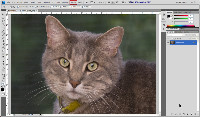 I'll start with this photo of Scampi, the hacker cat. Scampi used to go with me on Sundays to WTVN for Technology Corner. He usually tried to jump from the window of the car to the open window at Tim Horton's when I stopped for coffee. At the radio station, he sat silently until our microphones were on. Then he started meowing. While Joe and I spoke to all the people listening, Scampi addressed all the felines.
I'll start with this photo of Scampi, the hacker cat. Scampi used to go with me on Sundays to WTVN for Technology Corner. He usually tried to jump from the window of the car to the open window at Tim Horton's when I stopped for coffee. At the radio station, he sat silently until our microphones were on. Then he started meowing. While Joe and I spoke to all the people listening, Scampi addressed all the felines.
I selected this image of Scampi because it contains fine detail in his fur, a decent range of tones, and sharp highlights in his eyes.
Although I can't show you every filter in the tool kit, I can show you some of the filters in the tool kit. The range and depth are amazing.
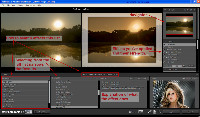 The screen layout is easy to understand. At the lower left, you can type a word to search for a particular effect to limit the list shown in the center column. Additionally, if you have an effect that you use often, right-click it and make it one of your favorites.
The screen layout is easy to understand. At the lower left, you can type a word to search for a particular effect to limit the list shown in the center column. Additionally, if you have an effect that you use often, right-click it and make it one of your favorites.
In the lower right corner, you'll see an example of what the filter does even before you apply it to your image.
In the upper left, there's a navigation area that allows you to zoom in and out to see more detail. Below the navigation section is the stack of effects that you've applied to the image. These can be turned on and off individually and faded.
If you decide that you don't like the effect, click the Reset button.
And when you're ready to apply the effect and return to Photoshop, click Apply. Or to cancel the entire operation, click Cancel. When you return to Photoshop, you'll find that your existing image has a new layer and that the effects have been applied to that new layer. Your original image is untouched.
Your Images, Modified
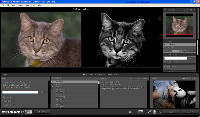 '30s Noire: This is a filter that attempts to create the look or 1930s detective films. Can you imagine the kitty as Sam Spade? Neither can I. But I can imagine a stylized photo of someone dressed in 30s-like clothing.
'30s Noire: This is a filter that attempts to create the look or 1930s detective films. Can you imagine the kitty as Sam Spade? Neither can I. But I can imagine a stylized photo of someone dressed in 30s-like clothing.
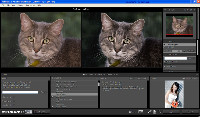 Bleach Bypass: These filters bring back some old memories. When film and paper had to be developed in chemicals, you might occasionally modify the process to create a special effect. If you omit the bleach step in processing color film, the film retains some of the silver that is usually removed. The result is less saturated colors, more grain, more contrast, and a darker image.
Bleach Bypass: These filters bring back some old memories. When film and paper had to be developed in chemicals, you might occasionally modify the process to create a special effect. If you omit the bleach step in processing color film, the film retains some of the silver that is usually removed. The result is less saturated colors, more grain, more contrast, and a darker image.
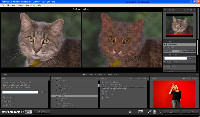 Comic Book: This isn't an ideal image to use with the comic book filter. It's better to start with a higher-contrast image. The result is an effect that replicates what the image would look like in either (your choice) a black-and-white or color comic book (also known as "graphic novel").
Comic Book: This isn't an ideal image to use with the comic book filter. It's better to start with a higher-contrast image. The result is an effect that replicates what the image would look like in either (your choice) a black-and-white or color comic book (also known as "graphic novel").
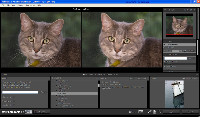 Colored Pencil: By any measure, this is an "artistic" effect. It attempts to make the image appear as it would if, instead of a photograph, it had been an image created with colored pencils on paper. This could be one of your favorites.
Colored Pencil: By any measure, this is an "artistic" effect. It attempts to make the image appear as it would if, instead of a photograph, it had been an image created with colored pencils on paper. This could be one of your favorites.
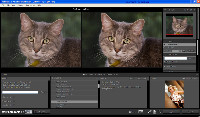 Creamsicle A4: Many of the effects are subtle and require careful comparison of the original (left) with the modification (right). This would be a good filter for use with portraits because it softens the image just slightly and applies a bit of warming.
Creamsicle A4: Many of the effects are subtle and require careful comparison of the original (left) with the modification (right). This would be a good filter for use with portraits because it softens the image just slightly and applies a bit of warming.
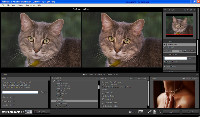 Diffuse Glow: Adding a diffuse glow to an image slightly softens highlights. This filter provides several additional pre-sets that can be used to tune the effect to your liking.
Diffuse Glow: Adding a diffuse glow to an image slightly softens highlights. This filter provides several additional pre-sets that can be used to tune the effect to your liking.
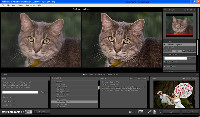 Enter the Dragon A4: Sometimes you run out of names and an effect picks up a name like "Enter the Dragon A4". I could see this filter being used to accentuate wrinkles and scars on a photograph of an older person whose face has developed character from life. The contrast is up, edges are highlighted, and the depth of the image is increased.
Enter the Dragon A4: Sometimes you run out of names and an effect picks up a name like "Enter the Dragon A4". I could see this filter being used to accentuate wrinkles and scars on a photograph of an older person whose face has developed character from life. The contrast is up, edges are highlighted, and the depth of the image is increased.
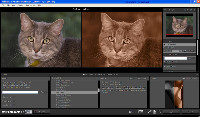 Gold Toner: This image and the next use the same filter. The image is first converted to monochrome and then colored to give the appearance of a selenium print. Selenium toning is used to make black-and-white prints more stable. The selenium replaces some of the silver and makes the print more resistant to pollutants such as sulphur.
Gold Toner: This image and the next use the same filter. The image is first converted to monochrome and then colored to give the appearance of a selenium print. Selenium toning is used to make black-and-white prints more stable. The selenium replaces some of the silver and makes the print more resistant to pollutants such as sulphur.
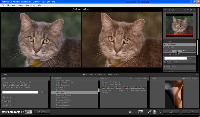 Gold Toner (reduced): Here is the same effect, but I've reduced the amount of the effect to about half of its full intensity. As a result, the gold tone is reduced and some of the original color remains.
Gold Toner (reduced): Here is the same effect, but I've reduced the amount of the effect to about half of its full intensity. As a result, the gold tone is reduced and some of the original color remains.
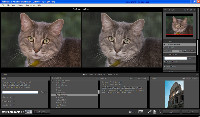 Gum Bichromate: Gum bichromate was used in the 1800s. Although it was typically a muti-pass process that printed in layers, some gum bichromate processes used just a single layer. Natural colors are possible with the process, but the colors themselves are muted. This filter recreates the antique process, but without all the chemicals.
Gum Bichromate: Gum bichromate was used in the 1800s. Although it was typically a muti-pass process that printed in layers, some gum bichromate processes used just a single layer. Natural colors are possible with the process, but the colors themselves are muted. This filter recreates the antique process, but without all the chemicals.
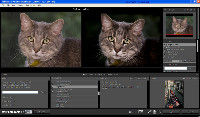 Holga Color: Holga is a brand of toy camera that uses 120 roll film. The camera is plastic. The lens is plastic. The results are technically poor, but some consider this "artistic". In 1982, when the camera was invented, black-and-white 120 roll film was commonly used in China. The Holga was an inexpensive mass-market camera. The cameras are still available, but now they cost $70. This filter mimics the kind of image you would expect from the Holga.
Holga Color: Holga is a brand of toy camera that uses 120 roll film. The camera is plastic. The lens is plastic. The results are technically poor, but some consider this "artistic". In 1982, when the camera was invented, black-and-white 120 roll film was commonly used in China. The Holga was an inexpensive mass-market camera. The cameras are still available, but now they cost $70. This filter mimics the kind of image you would expect from the Holga.
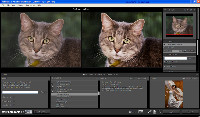 Hollywood Glow A3: This filter increases the contrast and causes the brighter colors to "pop". For this image, the full-strength filter is a bit too much.
Hollywood Glow A3: This filter increases the contrast and causes the brighter colors to "pop". For this image, the full-strength filter is a bit too much.
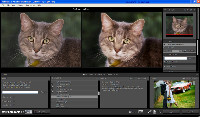 Hollywood Intensity A1: Many movies have been made in which the lens focused on the actor through a fine black mesh. This softens the image by reducing lines and de-emphasizing blemishes.
Hollywood Intensity A1: Many movies have been made in which the lens focused on the actor through a fine black mesh. This softens the image by reducing lines and de-emphasizing blemishes.
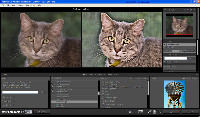 Illustrative Edge: This may be the perfect example of the wrong filter for an image. Images of people and animals will not be improved by the illustrative edge filter, but some scenic images will be.
Illustrative Edge: This may be the perfect example of the wrong filter for an image. Images of people and animals will not be improved by the illustrative edge filter, but some scenic images will be.
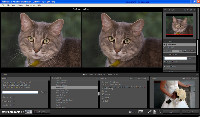 Impression: This is another artistic, painterly effect.
Impression: This is another artistic, painterly effect.
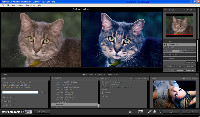 X-Process A1: Somebody made a mistake one day and processed print film in chemicals intended for color slides or color slides in chemicals intended for color negative film. The colors were all wrong, but the effect was interesting. Cross processing was born.
X-Process A1: Somebody made a mistake one day and processed print film in chemicals intended for color slides or color slides in chemicals intended for color negative film. The colors were all wrong, but the effect was interesting. Cross processing was born.
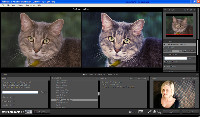 Kev-X Process Combo A1: Similar to the effect above, this is somewhat lighter and with less of a color cast.
Kev-X Process Combo A1: Similar to the effect above, this is somewhat lighter and with less of a color cast.
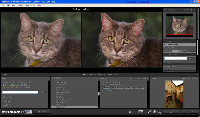 Kodachrome: In the song of the same name, Paul Simon praised the film, "They give us those nice bright colors. They give us the greens of summers." This was the film that was a perennial favorite of amateurs because of the bright, highly saturated colors. Professionals generally used Ektachrome, which was more neutral and life-like. This filter pushes the saturation a bit and increases the contrast.
Kodachrome: In the song of the same name, Paul Simon praised the film, "They give us those nice bright colors. They give us the greens of summers." This was the film that was a perennial favorite of amateurs because of the bright, highly saturated colors. Professionals generally used Ektachrome, which was more neutral and life-like. This filter pushes the saturation a bit and increases the contrast.
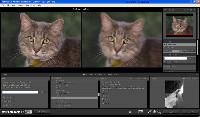 Lens Zoom: If you create a long exposure and zoom a lens in or out while the shutter is open, the result is what you see here. It's a way to create a feeling of speed in the photograph and to emphasize what's in the center. One of the few shortcomings of Photo Tools 2 is the inability to place the center of the zoom effect somewhere other than the center of the image. This would be impossible in the camera, of course, but it would be helpful when you want the zoom centered on something that's not in the center of the image.
Lens Zoom: If you create a long exposure and zoom a lens in or out while the shutter is open, the result is what you see here. It's a way to create a feeling of speed in the photograph and to emphasize what's in the center. One of the few shortcomings of Photo Tools 2 is the inability to place the center of the zoom effect somewhere other than the center of the image. This would be impossible in the camera, of course, but it would be helpful when you want the zoom centered on something that's not in the center of the image.
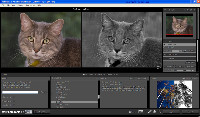 Ortho Film: Do not use this filter for people, or cats for that matter. Orthochromatic emulsions are sensitive only to blue and green light. Blue objects appear lighter and red ones appear darker. Because human pigment contains a lot of red and not a lot of blue or green, the result is unappealing for humans.
Ortho Film: Do not use this filter for people, or cats for that matter. Orthochromatic emulsions are sensitive only to blue and green light. Blue objects appear lighter and red ones appear darker. Because human pigment contains a lot of red and not a lot of blue or green, the result is unappealing for humans.
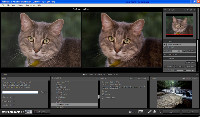 Orton Hears a Who: It's easy to diffuse highlights in the camera, but diffusing shadows requires darkroom manipulation. This filter diffuses shadows and darker areas of the image, while adding a bit of warming.
Orton Hears a Who: It's easy to diffuse highlights in the camera, but diffusing shadows requires darkroom manipulation. This filter diffuses shadows and darker areas of the image, while adding a bit of warming.
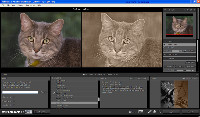 Sepia Toner: Sepia toning is primarily an antique process that was used for black-and-white prints. The metallic silver in the print is converted to a sulfide compound, which is more resistant to pollutants such as sulfur. The process creates a print that no longer has strong blacks.
Sepia Toner: Sepia toning is primarily an antique process that was used for black-and-white prints. The metallic silver in the print is converted to a sulfide compound, which is more resistant to pollutants such as sulfur. The process creates a print that no longer has strong blacks.
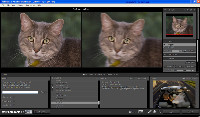 Wiggle It (eyes painted out): Most photographers try to keep the camera steady and some even use a tripod to ensure steadiness. But sometimes you want the image to show the effects of camera shake. That's what this filter does, but you can paint-out some areas of the image (the eyes here) so that they remain sharp.
Wiggle It (eyes painted out): Most photographers try to keep the camera steady and some even use a tripod to ensure steadiness. But sometimes you want the image to show the effects of camera shake. That's what this filter does, but you can paint-out some areas of the image (the eyes here) so that they remain sharp.
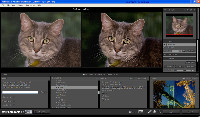 HDR Look: Photographs that reproduce a high dynamic range (HDR) have a unique appearance because extreme highlights and extreme shadows must be compressed to the range of the medium involved. This filter converts a standard photograph to appear as it would if it had been created from a series of images combined for the HDR effect.
HDR Look: Photographs that reproduce a high dynamic range (HDR) have a unique appearance because extreme highlights and extreme shadows must be compressed to the range of the medium involved. This filter converts a standard photograph to appear as it would if it had been created from a series of images combined for the HDR effect.
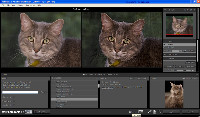 Crayon: And another artistic effect, that of an image drawn with sharp crayons on textured paper.
Crayon: And another artistic effect, that of an image drawn with sharp crayons on textured paper.
Looking Closer
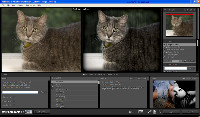 The image at the right uses a "preset", which applies several effects and layers them. The 6 effects used here are listed at the right side of the image.
The image at the right uses a "preset", which applies several effects and layers them. The 6 effects used here are listed at the right side of the image.
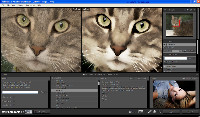 Some of the effects are intended to be painted in or painted out. Here's an anime filter that's intended to reproduce the look of an anime drawing. It's fine when applied to the entire image, but what if I wanted to omit the effect on the eyes?
Some of the effects are intended to be painted in or painted out. Here's an anime filter that's intended to reproduce the look of an anime drawing. It's fine when applied to the entire image, but what if I wanted to omit the effect on the eyes?
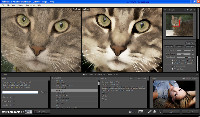 The difference is relatively subtle, but here I've masked out Scampi's eyes, his nose, and a bit of his mouth.
The difference is relatively subtle, but here I've masked out Scampi's eyes, his nose, and a bit of his mouth.
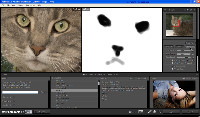 I can see the actual mask here.
I can see the actual mask here.
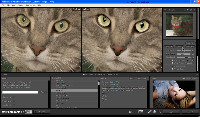 And with a single mouse click, I can invert the mask so that Scampi's eyes, nose, and mouth have the anime effect, but his fur does not.
And with a single mouse click, I can invert the mask so that Scampi's eyes, nose, and mouth have the anime effect, but his fur does not.
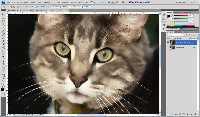 Here is the image with the effect applied and returned to Photoshop for any additional work I might want to do.
Here is the image with the effect applied and returned to Photoshop for any additional work I might want to do.
The Professional version includes 290 effects and works from inside Photoshop and Lightroom (Windows) or Photoshop, Lightroom, and Aperture (Mac). The standard version omits the ability to work from inside Lightroom and Aperture but still includes 180 effects. Even the free Lite version comes with 14 basic effects.
 Bottom Line: Photo Tools Pro 2 is a must-have application for photographers who value their time as much as their craft.
Bottom Line: Photo Tools Pro 2 is a must-have application for photographers who value their time as much as their craft.
It's hard to imagine a more productive way for a professional photographer or an advanced amateur to spend $260 than to purchase Photo Tools 2 Pro. If you're on a budget, the $160 version includes a lot of powerful features and even the free "Lite" version covers the basics.
For more information, visit the OnOne Software website.
Short Circuits
Making Microsoft (and the IT Security Guy) Nervous
Microsoft Office is king of the desk, but Google is king of the cloud. And the cloud is challenging the desk. About 20% of companies in a recent survey said that they use Google Docs in their offices. Many use these applications in conjunction with Office applications on desktop computers and most of the companies that rely heavily on Google are still smaller companies, but the trend is toward net-based computing.
The survey was conducted by IDC, which talked to 262 office workers, mostly senior managers. About one third of the respondents worked for companies with fewer than 100 employees and another third worked for companies with more than 5000 employees. A similar survey just 2 years ago showed that only 5% of those surveyed said that they made significant use of Google Docs. When a company quadruples penetration in just two years, that gets the competitions' attention.
Nearly everyone in the survey (97%) said that Microsoft applications are still being used in their organizations. Microsoft has Web-based tools, too, and those might simply steal customers from the desktop suite of applications.
Security specialists are nervous about Web-based computing because storing proprietary documents with business plans outside the company automatically creates concerns.
Let's Find Something to Sell to Adobe
Analysts are saying that Adobe overpaid by about double its worth to buy Omniture for about $1.8 billion. Adobe is a company that has made a name for itself by developing top graphics applications, but also by acquiring other companies that offer features Adobe believes should be core to its business. The best known example of this is the Macromedia acquisition, but there have been many others.
Omniture is a Web analytics software company, and one can easily see how such a company's products could be integrated into Adobe's Web development tools. For now, though, Adobe says it will continue to run Omniture as a separate business.
The acquisition cost is $21.50 a share in cash. That's nearly 25% more than Omniture's selling price on the day of the deal. Omniture is based in Orem, Utah, the home town of Wordperfect, and it sells software applications that analyze website traffic and that help companies improve their marketing.
Adobe earned $136 million in the just-ended 3rd fiscal quarter, down nearly 30% from last year.
Speaking of Finance and Acquisitions ...
Quicken has announced plans to acquire Mint.com and expects the deal to close by the end of the year. Mint.com is a provider of online personal finance solutions that is used by about 1.5 million people. Intuit's Quicken already has an on-line presence, but Intuit says that Mint.com offers a fresh, new approach.
According to Intuit, Mint.com will gain access to resources of scale. Mint CEO Aaron Patzer says that both companies share a passion for providing easy-to-use solutions for personal finance.
Intuit has been in business for 25 years and is the publisher of Quicken, QuickBooks, and TurboTax. It will pay about $170 million for Mint.com.
Intuit says it will continue its desktop applications, online services, and mobile products because users of those products want the continuity of programs they're familiar with.


 The author's image: It's that photo over at the right. This explains why TechByter Worldwide was never on television, doesn't it?
The author's image: It's that photo over at the right. This explains why TechByter Worldwide was never on television, doesn't it?
